Twelve of 2017's most powerful images and the moving stories behind them
IBTimes UK asked 12 Getty Images photojournalists to choose their most memorable photo of the year and tell us the story behind the picture.
A man shielding a woman during the Las Vegas shooting, a desperately hungry child pleading for food, a soldier using one of the oldest tricks in the book... These were some of the most memorable images of 2017. IBTimes UK asked 12 Getty Images photojournalists to choose their most memorable photo of the year and tell our readers the story behind it. The results are insightful and often unbearably moving.
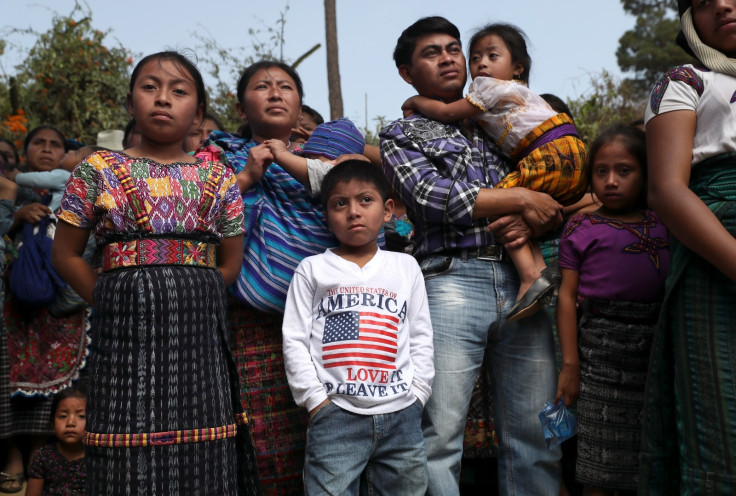
John Moore, 14 February 2017: Villagers attend a memorial service for two boys who were kidnapped and killed while walking to school in San Juan Sacatepéquez, Guatemala. When their families could not pay the ransom, the boys were killed and stuffed into sacks. The murders shook the Kaqchikel-speaking Mayan residents of the village, an hour west of Guatemala City. Such savage violence, especially in Guatemala, El Salvador and Honduras has driven migration from Central America to the United States.
Family members held a wake for the two boys in Oscar's home. The two were neighbours and schoolmates. A crowd of people filled the street outside the house, silently lining up to to go inside for the viewing. One by one, people filed past the bodies, peering into the glass-topped caskets, laid out side by side, as the sound system played the theme song to "The Young and the Restless" on loop. During the procession pall bearers carried the small coffins, and the entire population of 2,000 people walked along to the discordant notes of a small brass band. The boys' teachers openly wept into the microphone at a memorial service held at village's elementary school.
In this photograph, a schoolmate looks on, wearing a second-hand sweatshirt, reading "America. Love it or Leave it." The slain children came from different families, but they were both interred in the tomb of Oscar's family. The children died together and together they will remain.

David Ramos, 18 February 2017: Najwa Musse, 16, and her boyfriend Suleiman Ahmed, 18, both from Libya are seen on deck of a rescue vessel after being rescued at sea, 24 miles (46km) north of Sabratha, Libya. Early this year I had the privilege to join a search and rescue mission on the Mediterranean with the Spanish Proactiva Open Arms NGO along the Libyan coast. I was on board the rescue vessel Golfo Azzurro for two weeks. It was a tough mission with very bad sea and some mechanical issues.
Two days before returning to shore we got an emergency call from the Maritime Rescue Coordination Centre (MRCC) in Rome, some small boats in distress had been spotted on the radar some miles away of our position. After 24 hours of a non-stop rescue operation the lifeguards of the NGO rescued 466 people. It was the biggest operation during winter time. Although it was considered a successful mission, around 100 people drowned that day (more than 3,000 drowned this year). That's 100 people like Najwa and Suleiman.
This picture shows a tender moment between Najwa Musse, 16, and her boyfriend Suleiman Ahmed, 18, after spending a cold night on the Golfo Azzurro's deck. They were rescued the day before. I like her smile, how she caresses his chin and she wraps him in the blanket. You could feel how rescued people once on board the vessel were again human beings after being treated as merchandise by the smugglers. It is a love story among hundreds of thefts, slavery, rapes and deaths. They are not just a number sailing and drowning at the Mediterranean. They are human beings like we are, people who fall in love, smile, laugh, make jokes... Even in the worst conditions I have ever seen.
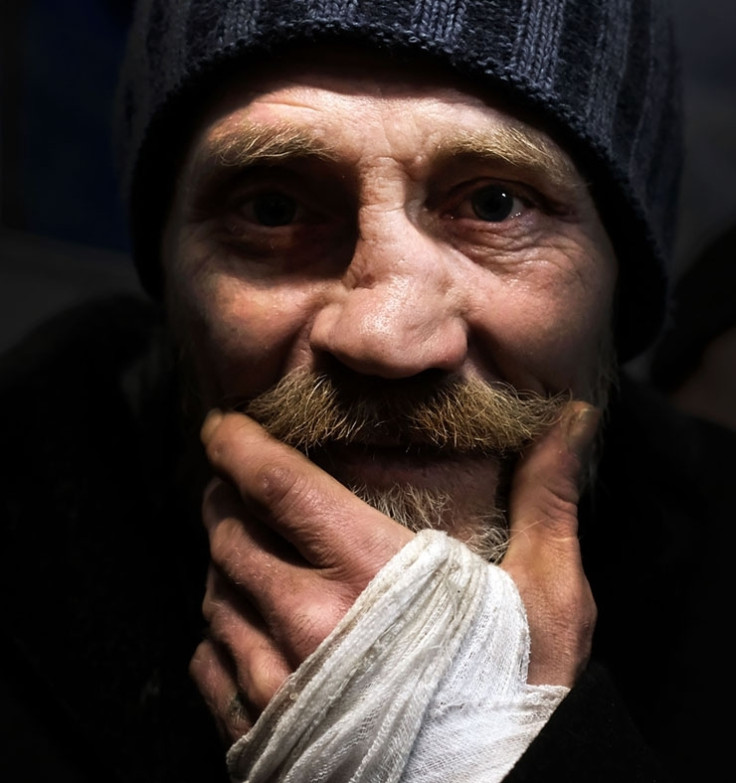
Spencer Platt, 7 March 2017: Georgy, a homeless man from Siberia, pauses for a portrait at a clinic which helps Moscow's disadvantaged. Working for the news wire at Getty Images I go through many pictures in a day – they quickly become a blur as the next assignment pulls for my attention. This year has been one of the most visually dynamic periods I can ever recall with wildfires, destructive hurricanes and the daily drama of the Trump presidency among so many other important stories.
One picture that comes to mind was taken in Russia in a tent for the homeless on the outskirts of Moscow. While I do enjoy the adrenaline and rush of breaking news stories, I am most content wandering alone in a strange city with a few small cameras. My photographic idol is Ernst Haas; he wasn't exactly a photojournalist but shot in a style I would call art reportage, or wandering with a visual purpose. I wasn't in Russia on a journalist visa so I had to keep a low profile. I had discovered this homeless outreach project and found the men and few women staying there both tragic and fascinating. Most had come from remote regions of Russia looking for work after stints in the army. They smelled of alcohol and cigarettes but were very polite and engaging.
Georgy had come from Siberia where he had left his family. He fell while working on a construction site and injured his arm preventing him from working. He had the bearing and mannerisms of a character out of a Chekhov book but had fallen into a difficult life. It was not until that hour or two that I spent with these homeless individuals that I got a glimpse of the tragic and beautiful Russian soul. It's for reasons like this that I love photojournalism, it compels you to engage with people and situations one normally wouldn't. I think this ultimately creates a richer understanding of our world and place in it. Some days I'll wonder what ever happened to Georgy. Is he alive? Did he make it back to Siberia to be with his family? It is those questions that I find most haunting and beautiful.

Carl Court, 13 April 2017: An Iraqi federal policeman uses a helmet on a stick to try and draw fire from an Islamic State sniper in an attempt to make him reveal his position during the battle to recapture west Mosul. This photograph was taken during my second visit to Mosul to document the liberation of the city from Islamic State by Iraqi government and Kurdish forces. By this point in April 2017, over six months since the beginning of the operation, large numbers of Isis fighters had been killed and their fighting force had largely been reduced to snipers who were holed up deep in the Old City. Although small in number they were highly effective and well trained – an Iraqi soldier had joked to me that if I even poked my thumb above the rooftop it would get shot off.
Because of the maze of alleyways and streets in this part of Mosul, Iraqi forces were having to fight house to house in what a US commander had described as the most brutal urban combat since World War 2. After several exhausting hours on a front line covering the efforts of the Iraqi Federal Police to retake an Isis position, I moved along to another rooftop on an adjoining building. I had heard shouting coming from there and chose to take a look, expecting to see soldiers firing on nearby Islamic State fighters (some had been as close as the the next rooftop). I came across a Federal Policeman holding a helmet on a stick that he was poking over the rooftop to entice snipers to take aim and give their position away by the flash of fire from their muzzle. The scene was strangely serene and, in a battle that had employed some of the most advanced military technology in the world, it was proof that one of the oldest tricks in the book can still work.

Chris McGrath, 24 May 2017: A woman cries after losing her baby in the water as she sits in a rescue boat from the Migrant Offshore Aid Station (MOAS) Phoenix vessel off Lampedusa, Italy. I was in the small inflatable rescue craft with four of the rescue crew attending to a wooden boat carrying some 600 refugees and migrants. The boat had tipped over en route to Italy from Libya tossing hundreds in the water. It was a chaotic scene with people everywhere struggling in the water.
It was a situation where despite me being there to photograph, there was no way at all of not participating and helping in the rescue efforts as people tried to climb into the boat. Rescue crews were overwhelmed pulling scores of people from the water. I was in the back of the rescue boat when we pulled up next to a small group of people and began pulling them into the boat. I saw this woman at the back and with the help of another crew member we pulled her into the boat before I stepped away to help pull another person in. I heard her crying and screaming "Baba, Baba" and realised she had lost her baby in the water. I frantically ran to the back of the boat and searched the water on either side of the boat looking for her baby, I couldn't see it anywhere. I have never felt so helpless.
As the rescue craft pulled away to rescue yet more people from the water I held her hand; there is nothing to say in this situation. Amongst all that I shot just six frames of her and to be honest don't even remember when or how I did it. Rescue crews later found her baby but were unable to revive it – as was the outcome for all the children and babies on that boat. The only surviving child was a 13-year-old boy.

Justin Sullivan, 8 June 2017: A bar patron at Ace's Bar in San Francisco watches a television broadcast as former FBI Director James Comey testifies before the Senate Intelligence Committee. This photo is the perfect summation of how Americans feel about the political climate in 2017. It looks like this man has had several drinks while watching former FBI Director James Comey's testimony at a Senate hearing and appears to be completely drained.
Americans will remember 8 June 2017 as a monumental day in which Mr Comey took the stand and revealed his private discussions with President Trump – an unprecedented act in modern American politics. Though we have seen increased political activism in 2017, the outlandish rhetoric and 24-hour news cycles are taking its toll on the American public.
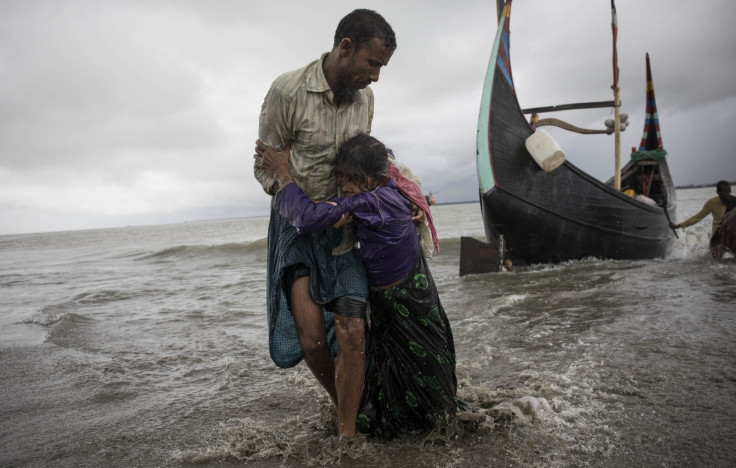
Dan Kitwood, 12 September 2017: A Rohingya man carries an elderly woman, after the wooden boat they were travelling on from Myanmar, which can be seen in the background, crashed into the shore and tipped everyone out in Dakhinpara, Bangladesh. I had been stood on the beach with my fixer for several hours waiting as we had been told that many of the Rohingya refugees had been arriving there after fleeing Myanmar. Fires could still be seen over the five-kilometre stretch of the Naf River in Myanmar as villages continued to be razed to the ground.
A wooden boat approached, with around 25 Rohingya Muslim refugees onboard. As it hit the shore a wave caught it side-on, tipping it over and almost everyone – including elderly men, women and children – fell into the water. Weighed down by both the sea water and the traumatic experiences they had left behind, everyone collapsed on the beach all around me, exhausted. Everyone was hysterical, and at first I couldn't really work out what was going on. I thought perhaps that someone had been left in the water and worried they may have drowned.
It became clear though that just to compound their misery, the two 'captains' of the boat, young men in their mid-twenties, had stopped half way across and robbed everyone of their jewellery and were trying to make off with it before the coastguard arrived. The coast guard fortunately arrived and the young men were 'encouraged' to hand back their loot.
I was asked to leave so I don't know the fate of the elderly woman who had collapsed at my feet. I just hope she made it. The scene I witnessed that morning on the beach in Bangladesh while remarkable, was not unique. It wasn't a one off, just a small part of a bigger story unfolding across the greater region. It was just five minutes of madness that happened to play out before me. Part of another merry-go-round of misery, imparted on one of the most persecuted minorities on Earth who in this case happen to follow a different faith and apparently, according to the Myanmar government, have no claim to the land they simply wish to call home. The UN has condemned the actions against the Rohingya population, calling the Myanmar military's actions nothing short of ethnic cleansing, while Myanmar's defector leader and Nobel Prize winner Aung San Suu Kyi chose not to speak out, despite spending her life advocating for a democratic Myanmar.

Kevin Frayer, 20 September 2017: A Rohingya refugee boy desperate for aid cries as he climbs on a truck distributing aid for a local NGO near the Balukali refugee camp in Cox's Bazar, Bangladesh. This was the first real food distribution that I had seen and the scene was chaotic. People were shouting and reaching; I could feel the anxiety and I was struggling to work.
As I climbed on the truck to get a stronger view, people grew more distraught as they were obviously exhausted and hungry. That is when I saw this boy pull himself up on the truck. I couldn't hear much because everything around me was so loud, but I could see that he was weeping. Then he reached out his hands toward the man standing over the food and wrapped his arms around his leg. He was clinging to it, begging. This vulnerable child had clawed his way through a massive crowd and onto the truck in complete desperation. I was totally struck by the sadness of it.
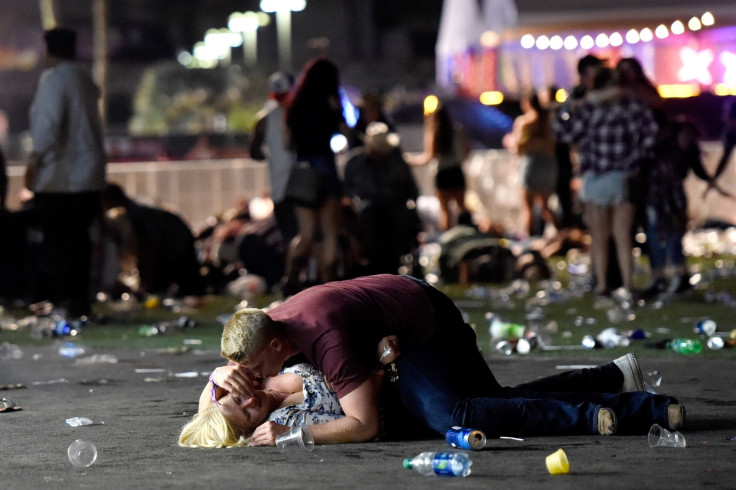
David Becker, 1 October 2017: A man lies on top of a woman as others flee the Route 91 Harvest country music festival grounds in Las Vegas after a active shooter was reported. After photographing the final act of the Route 91 Harvest country music festival, I began editing in the media tent when loud pops startled me. Security said it was the sound system malfunctioning. It seemed plausible, so I went back to work.
Moments later, loud pops rang out again. This time, concertgoers began fleeing. I picked up my cameras and started taking photos of the panic as people ran for cover, some lying still on the ground. Not sure what was happening, I told myself repeatedly it was only speakers. Under extreme low light conditions, I tried to capture what was going on, still unsure of what it was.
Ten minutes later, while editing in the pitch-black media tent, the only visible light came from my computer screen illuminating a tragedy unfolding. I realised that I was witnessing the worst mass murder in US modern history.
The photograph of the man shielding a woman stands out for me. It was what the aftermath of the shooting was about – strangers, like this man, who chose to risk their own lives to help others. As for the outcome of this photo, I saw them run off and escape harm. Horribly, 58 others lost their lives that night.
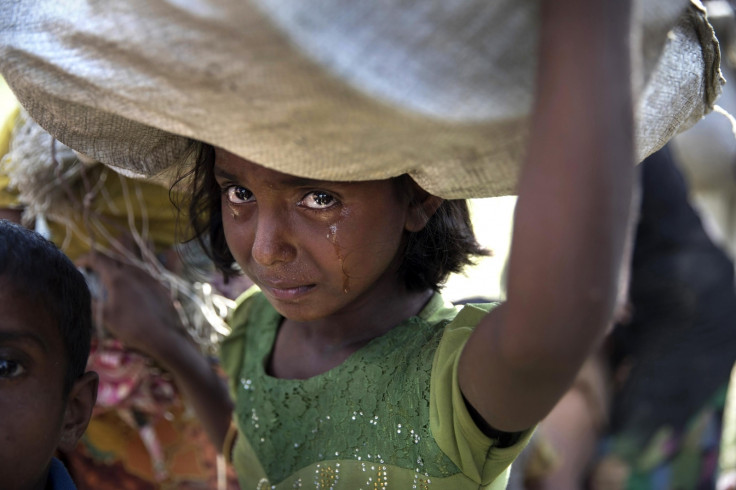
Paula Bronstein, 16 October 2017: A Rohingya girl cries as refugees fleeing from Myanmar cross a stream in the hot sun on a muddy rice field near Palang Khali, Cox's Bazar, Bangladesh. They had trekked for days carrying all of their belongings, mostly barefoot. The Rohingya were allowed to cross all at once, it seemed – on this day there were thousands.
The Bangladeshi Border Guards (BGB) were blowing whistles and using sticks to keep the everyone in control. They had allowed the Rohingya entry onto a road that allowed humanitarian organisations to assist for a few hours. In the early afternoon, they were suddenly sent back into the black muddy field because some "higher authority" wasn't quite sure what to do. Things with the government and the military were still unclear even after seven weeks of this refugee crisis. So the Rohingya were sent back for the next three days camping out in a temporary no man's land. They were scared. Nobody really understood what was going on.
This is when I got my photo of the vulnerable child who I felt really told the story of so many. She cried because there seemed to be no hope and she was utterly traumatised. Her emotions really touched me. Her other family members were also teary eyed and wanting to give up. Perhaps my presence helped for a few minutes as I offered more water and a banana, but it was all I had.
I had been covering this border crossing since 7:00am documenting the Rohingya's journey in conditions which were unbearable. Just trying to walk in the muddy waters along a narrow path, packed with refugees with the humid air in temperatures over 100F (38C). I had also managed to fall on a bamboo bridge covered with wet sandbags at around 7:30am, so along with a few bruises my Canon 70-200 F4 was in two pieces. Yes, it was another long day that would demand all of my energy. My stamina was pushed to the limit on a daily basis, but it was nothing compared to what the Rohingya had been dealing with.
The refugee emergency unfolded in late August after an attack on state security forces by Rohingya insurgents, triggering a brutal military crackdown that has forced more than half of the country's 1.1 million Rohingya Muslim population fleeing to neighbouring Bangladesh, creating the fastest cross-border exodus ever witnessed with over 650,000 new arrivals. Thousands of children who are travelling alone are at serious risk of trafficking and exploitation. Many traumatised refugees arrived telling stories of horror alleging rape, killings and the burning of hundreds of villages, which have been well documented by the media, along with the UN and various human rights groups.

Scott Olson, 9 November 2017: Charlene Uhl stares at a cross with the name and picture of her 16-year-old daughter, Haley Krueger, at a memorial where 26 crosses were placed to honour the 26 victims killed at the First Baptist Church of Sutherland Springs in Texas. I took this picture while covering the aftermath of the shooting in which 26 people were killed when a gunman opened fire inside the church during a Sunday service.
Someone had made crosses with the names of the 26 victims to serve as a memorial to each. They sat along the crime scene tape which was stretched alongside a rural highway that ran about a half block from the church. The crosses quickly became a focal point for people mourning the victims. Most of the people stopping by the memorial had little or no connection to the community but, they felt compelled to visit, leave flowers, or just stop to say a prayer for the victims.
This woman would stand looking at the memorial for several hours at a time, sometimes with a friend but, most often, alone. Sometimes a tear would run down her cheek, sometimes a passerby would stop and give her a hug but, most of the time, she just stood there staring. Her name was Charlene Uhl and she was fixated on the cross with the picture of her 16-year-old daughter, Haley Krueger, sitting at its base.
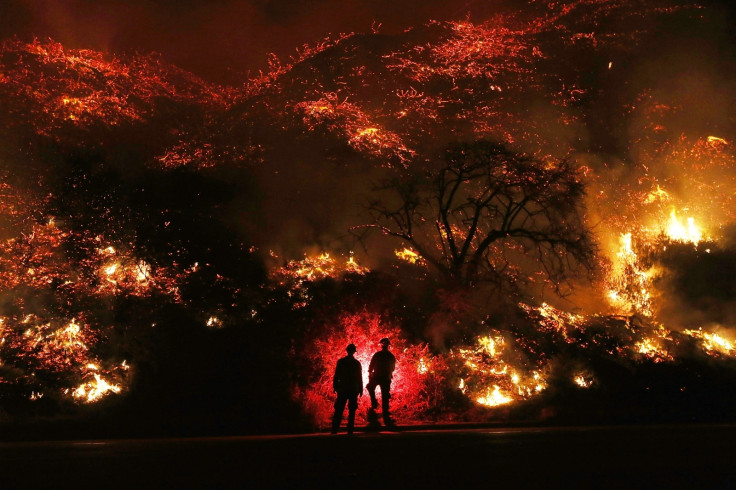
Mario Tama, 7 December 2017: Firefighters monitor a section of the Thomas Fire along the 101 freeway north of Ventura, California. I would say that this is the image that has made the most impact this year. I was in Los Angeles when the wildfires started and was blessed that fellow photographers Justin Sullivan, David McNew, Marcus Yam and Barbara Davidson coached me through the dangers, as this was my first time covering a wildfire.
I hope this image provides a window into the magnitude of challenges faced by the courageous first responders who put their lives on the line every day in Southern California. As of 21 December, the Thomas Fire had burned an area of 425 square miles (1,100 sq km), making it the second-largest wildfire in modern California history. As Governor Jerry Brown said on 60 minutes: "The fire season used to be a few months in the summer. Now it's almost year-long."
International Business Times UK thanks all of these Getty Images photojournalists for taking the time to share their stories with our readers.






















